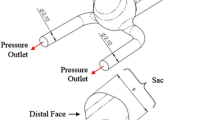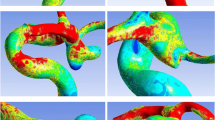Abstract
Hemodynamic changes in intracranial aneurysms after stent placement include the appearance of areas with stagnant flow and low shear rates. We investigated the influence of stent placement on blood flow velocity and wall shear stress of an intracranial aneurysm using a finite element modeling approach. To assess viscosity changes induced by stent placement, the rheology of blood as non-Newtonian fluid was taken into account in this model. A two-dimensional model with a parent artery, a smaller branching artery, and an aneurysm located at the bifurcation, before and after stent placement, was used for simulation. Flow velocity plots and wall shear stress before and after stent placement was calculated over the entire cardiac circle. Values for dynamic viscosity were calculated with a constitutive equation that was based on experimental studies and yielded a viscosity, which decreases as the shear rate increases. Stent placement lowered peak velocities in the main vortex of the aneurysm by a factor of at least 4 compared to peak velocities in the main artery, and it considerably decreased the wall shear stress of the aneurysm. Dynamic viscosity increases after stent placement persisted over a major part of the cardiac cycle, with a factor of up to 10, most pronounced near the dome of the aneurysm. Finite element modeling can offer insight into rheological changes induced by stent treatment of aneurysms and allows visualizing dynamic viscosity changes induced by stent placement.





Similar content being viewed by others
References
Lanzino G, Wakhloo AK, Fessler RD, et al. (1999) Efficacy and current limitations of intravascular stents for intracranial internal carotid, vertebral, and basilar artery aneurysms. J Neurosurg 91:538–546
Lylyk P, Cohen JE, Ceratto R, et al. (2001) Combined endovascular treatment of dissecting vertebral artery aneurysms by using stents and coils. J Neurosurg 94:427–432
Geremia G, Haklin M, Brennecke L (1994) Embolization of experimentally created aneurysms with intravascular stent devices. Am J Neuroradiol 15:1223–1231
Wakhloo AK, Tio FO, Lieber BB, et al. (1995) Self-expanding nitinol stents in canine vertebral arteries: hemodynamics and tissue response. Am J Neuroradiol 16:1043–1051
Sadasivan C, Lieber BB, Gounis MJ, et al. (2002) Angiographic quantification of contrast medium washout from cerebral aneurysms after stent placement. Am J Neuroradiol 23:1214–1221
Vanninen R, Manninen H, Ronkainen A (2003) Broad-based intracranial aneurysms: thrombosis induced by stent placement. Am J Neuroradiol 24:263–266
Foutrakis GN, Yonas H, Sclabassi RJ. (1997) Finite element methods in the simulation and analysis of intracranial blood flow. Neurol Res 19:174–186
Burleson AC, Strother CM, Turitto VT (1995) Computer modeling of intracranial saccular and lateral aneurysms for the study of their hemodynamics. Neurosurgery 37:774–782; discussion 782–774
Aenis M, Stancampiano AP, Wakhloo AK, et al. (1997) Modeling of flow in a straight stented and nonstented side wall aneurysm model. J Biomech Eng 119:206–212
Steinman DA, Milner JS, Norley CJ, et al. (2003) Image-based computational simulation of flow dynamics in a giant intracranial aneurysm. Am J Neuroradiol 24:559–566
Foutrakis GN, Yonas H, Sclabassi RJ (1999) Saccular aneurysm formation in curved and bifurcating arteries. Am J Neuroradiol 20:1309–1317
Scott S, Ferguson GG, Roach MR (1972) Comparison of the elastic properties of human intracranial arteries and aneurysms. Can J Physiol Pharmacol 50:328–332
Canham PB, Ferguson GG (1985) A mathematical model for the mechanics of saccular aneurysms. Neurosurgery 17:291–295
Steiger HJ, Aaslid R, Keller S, et al. (1989) Strength, elasticity and viscoelastic properties of cerebral aneurysms. Heart Vessels 5:41–46
Hayashi K, Handa H, Nagasawa S, et al. (1980) Stiffness and elastic behavior of human intracranial and extracranial arteries. J Biomech 13:175–184
Jackson SP, Nesbitt WS, Kulkarni S (2003) Signaling events underlying thrombus formation. J Thromb Haemost 1:1602–1612
Hirabayashi M, Ohta M, Rufenacht DA, et al. (2003) Characterization of flow reduction properties in an aneurysm due to a stent. Phys Rev E Stat Nonlin Soft Matter Phys 68:1–6
McMillan DE, Strigberger J, Utterback NG (1987) Rapidly recovered transient flow resistance: a newly discovered property of blood. Am J Physiol 253:H919–H926
Author information
Authors and Affiliations
Corresponding author
Rights and permissions
About this article
Cite this article
Ohta, M., Wetzel, S.G., Dantan, P. et al. Rheological Changes After Stenting of a Cerebral Aneurysm: A Finite Element Modeling Approach. Cardiovasc Intervent Radiol 28, 768–772 (2005). https://doi.org/10.1007/s00270-004-7148-6
Published:
Issue Date:
DOI: https://doi.org/10.1007/s00270-004-7148-6




